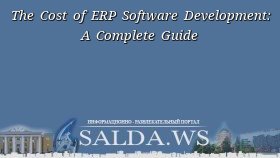- Hi-Tech, интернет, компьютеры
- Авто, мото
- Бизнес
- Бытовая техника
- Досуг, хобби, увлечения
- Живая природа
- Журналистика
- Закон и право
- Заметки о жизни
- Игры, программы
- Игры, развлечения
- Кулинария
- Культура, искусство
- Люди, знаменитости
- Мебель, обстановка
- Медицина, здоровье
- Мобильная связь, гаджеты
- Мода и стиль
- Музыка, кино, ТВ
- Музыка, концерты
- Наука, технологии
- Недвижимость
- Образование, учеба
- Обустройство быта
- Общество, политика
- Отдых, туризм
- Питание, диеты
- Полезные советы
- Праздники
- Пресс-релизы
- Программирование
- Промышленность, производство
- Прочее
- Психология
- Путешествия
- Работа, карьера
- Растительный мир
- Сайтостроение
- Семья, дом, дети
- СМИ, новости
- Спорт
- Строительство, ремонт
- Товары, услуги
- Финансы
- Шоппинг
- Юмор, приколы
The Cost of ERP Software Development: A Complete Guide
 In today's digitally driven business environment, ERP software development has become a crucial consideration for organizations striving for improved efficiency, integrated operations, and scalable growth. ERP (Enterprise Resource Planning) software helps manage core business processes such as finance, supply chain, manufacturing, human resources, and customer relationships. However, developing a custom ERP solution is a significant investment, both in terms of time and financial resources. This article will explore the costs associated with ERP software development, including influencing factors, pricing models, and cost-saving strategies.
In today's digitally driven business environment, ERP software development has become a crucial consideration for organizations striving for improved efficiency, integrated operations, and scalable growth. ERP (Enterprise Resource Planning) software helps manage core business processes such as finance, supply chain, manufacturing, human resources, and customer relationships. However, developing a custom ERP solution is a significant investment, both in terms of time and financial resources. This article will explore the costs associated with ERP software development, including influencing factors, pricing models, and cost-saving strategies.What Is ERP Software Development?
ERP software development refers to the process of designing, building, and deploying an enterprise resource planning system tailored to the specific needs of a business. Unlike off-the-shelf ERP solutions, custom-built ERP systems are designed with unique workflows, business rules, integrations, and user roles that reflect a company’s operational requirements.
While the benefits of ERP systems are numerous—streamlined processes, enhanced data visibility, improved decision-making—the development of such systems requires careful planning and budgeting. Understanding the cost of ERP software development is critical for making informed decisions and avoiding financial pitfalls.
Average Cost of ERP Software Development
The cost of erp software development can vary widely based on numerous factors. On average, small to medium-sized businesses can expect to pay between $30,000 to $250,000 for a custom ERP solution, while large enterprises might spend $500,000 to over $1 million depending on the complexity and scope of the system.
Here's a quick breakdown by business size:
Business Size Estimated Cost Range
Small Business $30,000 – $100,000
Medium Business $100,000 – $250,000
Large Enterprise $500,000 – $1,000,000+
These figures are only estimates. The actual cost of ERP software development will depend on several critical factors, which we will explore below.
Key Factors Influencing ERP Development Costs
1. Scope and Features
The number and complexity of features are perhaps the biggest determinants of cost in ERP software development. A basic ERP might include modules for:
Accounting and finance
Inventory management
HR and payroll
Sales and CRM
Procurement
However, a more complex ERP might involve:
Business intelligence and analytics
Production planning and control
Multi-currency support
Advanced reporting and dashboards
AI and machine learning capabilities
Each additional module increases both the development time and cost.
2. Customization Level
Off-the-shelf ERP solutions offer limited customization. Custom ERP software development, on the other hand, provides flexibility but at a higher cost. Custom workflows, approval hierarchies, personalized dashboards, and role-based permissions all require additional development hours, which directly impact the budget.
3. Number of Users
The number of end-users also affects development and licensing costs. A system designed for 10 users will be significantly less expensive than one for 500+ users, not only because of scale but also because of the need for better infrastructure and more robust performance optimization.
4. Platform and Technology Stack
ERP software development can be web-based, cloud-based, or hybrid. Developing cloud-based ERP solutions often costs more upfront due to the need for robust security, scalability, and multi-tenancy features.
The choice of technology stack—such as Python, Java, .NET, or Node.js—can influence the cost based on developer availability, licensing requirements, and integration compatibility.
5. Integration with Third-party Systems
ERP systems often need to integrate with existing tools like CRM, eCommerce platforms, accounting software, or legacy systems. Each integration point increases complexity and, consequently, the overall development cost.
6. UX/UI Design
Modern ERP systems need to be intuitive and user-friendly. Investing in a well-designed interface improves adoption and efficiency but may increase upfront design costs.
7. Development Team Location
The geographical location of your development team significantly affects cost. For example:
US/Canada/UK: $100 – $250/hour
Eastern Europe: $40 – $100/hour
India/Philippines: $20 – $50/hour
Hiring an offshore or nearshore team can reduce the total cost of ERP software development without compromising quality.
Cost Breakdown by Development Phase
1. Discovery and Planning Phase (5–10% of total budget)
Business requirement gathering
Workflow mapping
Technology stack selection
Timeline and budget estimation
Estimated cost: $5,000 – $50,000
2. Design Phase (10–15%)
UX/UI design
Prototyping
User feedback incorporation
Estimated cost: $10,000 – $75,000
3. Development Phase (40–50%)
Frontend and backend coding
Module development
API integrations
Data migration
Estimated cost: $50,000 – $500,000+
4. Testing and QA (10–15%)
Functional testing
Security testing
Load and performance testing
Estimated cost: $10,000 – $100,000
5. Deployment and Training (5–10%)
Server setup or cloud configuration
User training
Documentation
Estimated cost: $5,000 – $50,000
6. Maintenance and Support (10–20% annually)
Bug fixes
Performance optimization
Feature upgrades
Annual cost: 15–20% of initial development cost
In-House vs. Outsourced ERP Development
You have two primary options for ERP software development: building with an in-house team or outsourcing to a third-party vendor.
In-House Development
Pros:
Full control over the development process
Easier communication and collaboration
Tailored to business culture
Cons:
High salaries and benefits for developers
Requires recruitment and management
Longer time-to-market
Outsourced Development
Pros:
Cost-effective
Access to specialized skills
Faster turnaround
Cons:
Potential communication gaps
Time zone differences
Quality assurance challenges
In most cases, small to medium-sized businesses benefit more from outsourcing, while large enterprises might prefer building in-house teams or using a hybrid approach.
Hidden Costs in ERP Software Development
Apart from the obvious development costs, businesses must also prepare for several hidden costs:
Data Migration: Transferring legacy data to the new system can be time-consuming and costly.
Change Management: Training staff and adjusting business processes may require consultants.
Software Licensing: Some components (e.g., BI tools, middleware) may require separate licenses.
Downtime Risk: If not implemented carefully, ERP rollouts can cause temporary business disruptions.
Open Source ERP as a Cost-Saving Option
If budget is a major concern, open-source ERP systems like Odoo, ERPNext, or Dolibarr offer a more affordable entry point. These platforms are free to use but may still incur customization, hosting, and support costs.
For example:
Odoo: Free community version, with paid enterprise features
ERPNext: Highly customizable, ideal for SMEs
Dolibarr: Lightweight and simple, suitable for very small businesses
Using an open-source base and customizing it can cut the total cost of ERP software development by 40–60%.
ERP Software Development Cost Optimization Tips
Define Requirements Clearly: Avoid scope creep by finalizing business requirements before development begins.
Choose the Right Development Partner: Look for experience, technical skills, and ERP domain knowledge.
Use Agile Methodology: Agile development allows iterative improvements, better quality, and more predictable budgeting.
Start Small: Begin with a minimum viable product (MVP) and scale gradually.
Automate Testing: Automated QA tools can save time and reduce post-launch bugs.
Plan for Scalability: Design the system with future modules and growth in mind.
ROI of ERP Software Development
While the upfront cost of ERP software development can seem high, the return on investment (ROI) is significant when implemented correctly. Key ROI factors include:
Reduced operational costs
Increased productivity
Better inventory and resource management
Real-time insights and analytics
Improved customer satisfaction
According to a report by Panorama Consulting, companies that successfully implement ERP systems see a reduction in operational costs by 22% and an increase in productivity by 20% on average.
Conclusion
ERP software development is a critical investment that can revolutionize how a business operates. While the cost of ERP software development varies based on numerous factors—such as features, customization, team location, and integration needs—it ultimately provides immense value when aligned with strategic business goals.
Businesses must approach ERP software development with clear objectives, realistic budgets, and a long-term vision. Whether opting for a fully customized solution, enhancing an open-source platform, or choosing a modular approach, understanding the cost implications will ensure a smoother development process and a more effective ERP system.
By carefully planning and executing your ERP project, you can transform your operations, boost efficiency, and achieve a competitive edge in your industry.
Комментарии
Автор статьи
Информация
16 июня 2025 г. 11:55:42
Просмотров: 12
Статьи автора
У данного автора больше нет опубликованных материалов!
Похожие статьи


 24.07.2025 09:15:26
24.07.2025 09:15:26 22.03.2025 12:19:43
22.03.2025 12:19:43 11.12.2024 02:16:55
11.12.2024 02:16:55 02.10.2024 16:18:01
02.10.2024 16:18:01 06.09.2024 01:34:10
06.09.2024 01:34:10 24.07.2024 00:32:42
24.07.2024 00:32:42 17.05.2024 09:54:27
17.05.2024 09:54:27 28.04.2024 18:17:55
28.04.2024 18:17:55 17.04.2024 15:39:35
17.04.2024 15:39:35 09.04.2024 23:10:17
09.04.2024 23:10:17